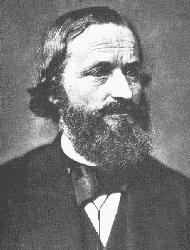




Gustav Robert Kirchhoff was born on 12 March 1824 in Koenigsberg (Germany). He graduated from the University of Koenigsberg in 1847, and after a few years of lecturing in Berlin and Breslau. In 1852 he took on a position at the University of Heidelberg where he remained till 1875. After moving to Berlin, his failing health forced him to prematurely retire in 1886. He died in Berlin on 17 October 1887.
Already as a student Kirchhoff made important contributions to electrical circuit theory, and he 1857 he produced a theoretical calculation demonstrating that an alternating electrical current flowing in a zero-resistance conductor would flow at the speed of light, which provided an important stepping stone towards the electromagnetic theory of light formulated in the 1890 by James Clerk Maxwell.
Kirchhoff most celebrated contributions to physics were in the field of spectroscopy. In collaboration with Robert Bunsen (1811-1899), Kirchhoff founded the (then purely empirical) science of spectroscopy. Kirchhoff and Bunsen began by effectively inventing the spectroscope, a prism-based device that separated light in its primary chromatic components, i.e., its spectrum, with which they began studying the spectral "signature" of various chemical elements in gaseous form.
The key observation made by Kirchhoff and Bunsen was that the spectral lines emitted by a gas occurred at the same wavelength (in modern parlance) as the absorption lines observed when incandescent light (provided by Bunsen's now famous gas burner) shone through the same gas heated at the same temperature. Kirchhoff took the gigantic leap of then identifying the dark spectral lines observed in the solar spectrum, known since Joseph Fraunhofer's earlier work, with the emission lines observed by various heated chemical substances. In this manner Kirchhoff (1) demonstrated the existence, in the Sun, of many chemical elements isolated on Earth, (2) argued that the bulk of the Sun is comprised of a hot, incandescent liquid, and (3) firmly established the hot, gaseous nature of the solar atmosphere. The latter two points led to the rapid demise of William Herschel's hypothesis of a dark, cold sun surrounded by luminous atmosphere, which Herschel had put forth on the basis of his sunspot model.
In the early 1960's Kirchhoff produced the first detailed map of the solar spectrum (ruining his eyesight in the process), while Bunsen busied himself with the spectroscopic discovery of hitherto unknown chemical elements (Caesium in 1860, and Rubidium in 1861). While subsequent spectroscopists improved greatly on Kirchhoff instrumental techniques, his work with Bunsen remains at the root of almost everything we know about the Sun and stars.
Meadows, A.J. 1970, Early Solar Physics, Pergamon
Porter, R. 1994, The Biographical Dictionary of Scientists, second ed., Oxford University Press.
 To search for a Solar Physicist
To search for a Solar Physicist
![]() To references and further reading
To references and further reading
last modification on january 18 2008 by
paulchar@astro.umontreal.ca
Tous droits réservés / Copyrighted by
Université de Montréal